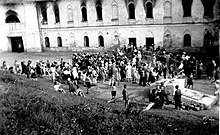Daugavpils Ghetto
| Daugavpils Ghetto | |
|---|---|

Jews in the Daugavpils ghetto, probably in August, 1941
|
|
| Also known as | Dvinsk ghetto, the Citadel, Ghetto Dünaburg |
| Location | Daugavpils, Latvia and vicinity, including Pogulyanka (Poguļanka) Forest (sometimes called Mežciems forest). |
| Date | June 26, 1941 to October 1943 |
| Incident type | Imprisonment, mass shootings, forced labor, starvation |
| Perpetrators | Erich Ehrlinger, Joachim Hamann, Günter Tabbert, Roberts Blūzmanis |
| Organizations | Nazi SS, Rollkommando Hamann, Arajs Kommando, Latvian Auxiliary Police |
| Victims | 13,000 to 16,000 Jews, mostly Latvians with some Lithuanians |
| Survivors | About 100 |
Following the occupation of Latvia by Nazi Germany in the summer of 1941, the Daugavpils Ghetto (German: Ghetto Dünaburg) was established in an old fortress near Daugavpils. Daugavpils is the second largest city in Latvia and the principal city of the Latgalia region. Daugavpils was located in southeastern Latvia on the Daugava River. The city was militarily important as a major road and railway junction. Before World War II, Daugavpils was the center of a thriving Jewish community in the Latgale region and one of the most important centers of Jewish culture in eastern Europe. Over the course of the German occupation of Latvia, the vast majority of the Jews of Latgale were killed as a result of the Nazi extermination policy.
The city of Daugavpils is also known by the Russian name of Dvinsk and the German name of Dünaburg. Many of the killings associated with the ghetto occurred in the nearby Pagulanka forest, which is also seen spelled as Polulanka and Pogulianski. Although known as a "ghetto", this old fortress was converted into a prison to hold Jews on a temporary basis before they were killed in the Pagulanka forest. Similar places in Latvia were called "concentration camps".
At that time, about 12,000 Jews lived in Daugavpils. In front of the German army, a huge column of refugees, including not only Jews from Lithuania, but Red Army soldiers separated from their units, began to move northeast on the highway from Kaunas (also known as Kovno) to Daugavpils, where the refugees expected to find safety or perhaps board a train for the east. Some Jewish refugees managed to reach the Soviet border, but they were prevented from crossing by NKVD guards. Eventually some were allowed to cross, but it was too late for most.
Following several days of aerial bombardment, the German army captured Daugavpils on June 26, 1941, but there was still fighting in the near vicinity for several days. A fire burned in the city, which the Nazis later chose to blame on the Jews. According to EK 1b's official report:
...
Wikipedia
